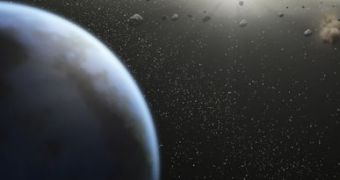Spanish researchers have concluded that the potentially hazardous asteroid '(101955) 1999 RQ36' has 1/1000 chance of hitting our planet, more likely during the year 2182. This research also involved researchers from the University of Pisa (Italy), the Jet Propulsion Laboratory (USA) and INAF-IASF-Rome (Italy), and it allows early intervention in the asteroid's path.
María Eugenia Sansaturio, co-author of the study and researcher of Universidad de Valladolid (UVA) explains to SINC that “The total impact probability of asteroid ‘(101955) 1999 RQ36' can be estimated in 0.00092 -approximately one-in-a-thousand chance-, but what is most surprising is that over half of this chance (0.00054) corresponds to 2182.”
Researchers have calculated the potential impact of the asteroid using two methods: the Monte Carlo Method and the line of variations sampling. The Virtual Impactors (VIs) have been searched and two of them appear in 2182, with more than half the chance of impact. VIs are groups of statistical uncertainty leading to collisions with the Earth on different dates in the 21st century, according to SINC.
The '(101955) 1999 RQ36' asteroid is part of the PHA - Potentially Hazardous Asteroids, that might hit the Earth because they are too close to its orbit. This asteroid has around 560 meters in diameter and has been discovered in 1999. Practically its orbit is already determined, but because of the Yarkovsky effect, there is a certain uncertainty. The Yarkovsky effect modifies the orbit of small objects in space as, while rotating, they radiate from one side the radiation they get from the sun on the other side.
If the effect is applicable to this asteroid, up to 2060 the deviation of the impacting orbits is moderate but it increases 4 orders of magnitude between 2060 and 2080. It continues to slowly increase until 2162, than it decreases and 2182 is the most probable year for the collision.
Sansaturio states that: “The consequence of this complex dynamic is not just the likelihood of a comparatively large impact, but also that a realistic deflection procedure (path deviation) could only be made before the impact in 2080, and more easily, before 2060.”
“If this object had been discovered after 2080, the deflection would require a technology that is not currently available. Therefore, this example suggests that impact monitoring, which up to date does not cover more than 80 or 100 years, may need to encompass more than one century. Thus, the efforts to deviate this type of objects could be conducted with moderate resources, from a technological and financial point of view,” she concludes.

 14 DAY TRIAL //
14 DAY TRIAL //